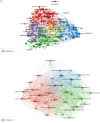Mapping the relationship between atopic dermatitis and gut microbiota: a bibliometric analysis, 2014-2023
- PMID: 39296293
- PMCID: PMC11408322
- DOI: 10.3389/fmicb.2024.1400657
Mapping the relationship between atopic dermatitis and gut microbiota: a bibliometric analysis, 2014-2023
Abstract
Background: Atopic dermatitis (AD) is a chronic inflammatory skin condition affecting a significant portion of the population, with prevalence rates of 25% in children and 7-10% in adults. AD not only poses physical challenges but also profoundly impacts patients' mental well-being and quality of life. The stability of gut microbiota is crucial for overall health and can influence AD progression by modulating immune function, skin barrier integrity, and neuroendocrine signaling, which may be an effective target for the prevention and treatment of AD. Thus, exploring the interactions between AD and gut microbiota, particularly in infants, can provide insights into potential preventive and therapeutic strategies. This study aimed to explore the correlation between AD and gut microbiota while providing an overview of current research trends and emerging areas of interest in this field.
Methods: A comprehensive search was conducted on the Web of Science Core Collection (WOSCC) for relevant publications from January 1, 2014, to December 31, 2023. English-language articles and reviews were included. Two investigators independently screened the publications, and visual analysis was performed using CiteSpace, VOSviewer, Scimago Graphica, and Microsoft Excel software.
Results: A total of 804 articles were included, showing a significant increase in publications over the past decade. The United States, Wageningen University, and University Ulsan (represented by Hong SJ) had the highest number of published papers. Nutrients was the journal with the most publications, while the Journal of Allergy and Clinical Immunology had the highest number of citations and centrality among co-cited journals. Keyword visualization analysis identified "atopic dermatitis" and "gut microbiota" as central themes. Notably, there has been a notable shift in research focus over the years, with early studies concentrating on "Fecal microbiota," "caesarean section," and "first 6 months," while recent studies have highlighted the roles of "cells," "dysbiosis," and "prebiotics." This shift indicates growing interest in the underlying mechanisms and potential therapeutic interventions related to the intestinal microecology in AD treatment.
Conclusion: The field of AD and gut microbiota research has evolved significantly, with an increasing focus on understanding the intricate interactions between gut microbiota and AD pathogenesis. Recent years have witnessed increased interest in understanding the relationship between AD and gut microbiota, with researchers conducting extensive studies exploring various aspects of this connection. This review analyzes research trends over the past decade, highlighting trends and hotspots in the study of AD, particularly in infants, and the role of microbiota. This review serves as a valuable reference for future investigations, aiming to provide deeper insights into this burgeoning field and suggests directions for future research.
Keywords: atopic dermatitis; bibliometric analysis; gut microbiota; hotspots; trends.
Copyright © 2024 Wang, Wang, Sun and Wang.
Conflict of interest statement
The authors declare that the research was conducted in the absence of any commercial or financial relationships that could be construed as a potential conflict of interest.
Figures










Similar articles
-
Mapping Research Trends and Hotspots in the Link between Alzheimer's Disease and Gut Microbes over the Past Decade: A Bibliometric Analysis.Nutrients. 2023 Jul 19;15(14):3203. doi: 10.3390/nu15143203. Nutrients. 2023. PMID: 37513621 Free PMC article. Review.
-
Emerging trends and research hotspots in the relationship between mast cells and atopic dermatitis based on the literature from 2001 to 2024: A bibliometric and visualized analysis.Skin Res Technol. 2024 Sep;30(9):e70053. doi: 10.1111/srt.70053. Skin Res Technol. 2024. PMID: 39234634 Free PMC article.
-
Bibliometric and visual analysis of intestinal flora and immunity.Medicine (Baltimore). 2024 Jan 26;103(4):e36575. doi: 10.1097/MD.0000000000036575. Medicine (Baltimore). 2024. PMID: 38277560 Free PMC article.
-
Global research trends on gut microbiota and metabolic dysfunction-associated steatohepatitis: Insights from bibliometric and scientometric analysis.Front Pharmacol. 2024 Jul 11;15:1390483. doi: 10.3389/fphar.2024.1390483. eCollection 2024. Front Pharmacol. 2024. PMID: 39070791 Free PMC article.
-
Gut microbiota in insulin resistance: a bibliometric analysis.J Diabetes Metab Disord. 2024 Feb 14;23(1):173-188. doi: 10.1007/s40200-023-01342-x. eCollection 2024 Jun. J Diabetes Metab Disord. 2024. PMID: 38932838 Review.
References
Publication types
Grants and funding
LinkOut - more resources
Full Text Sources
Miscellaneous

